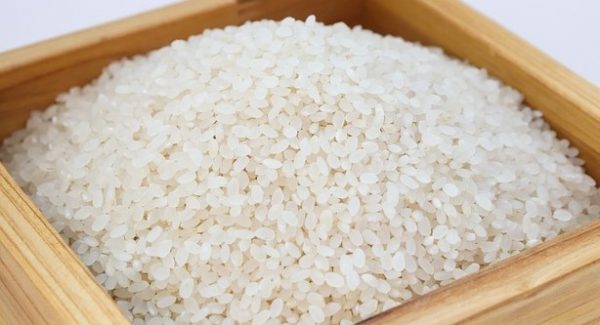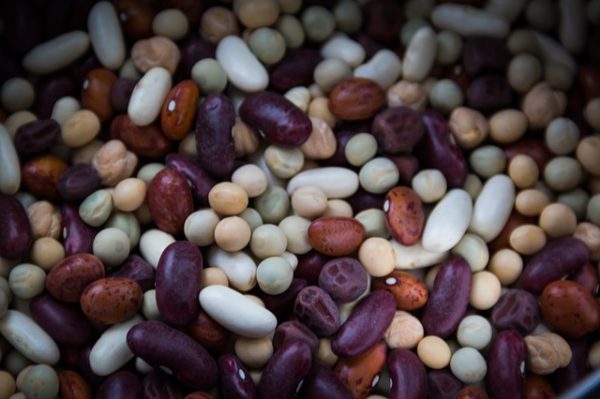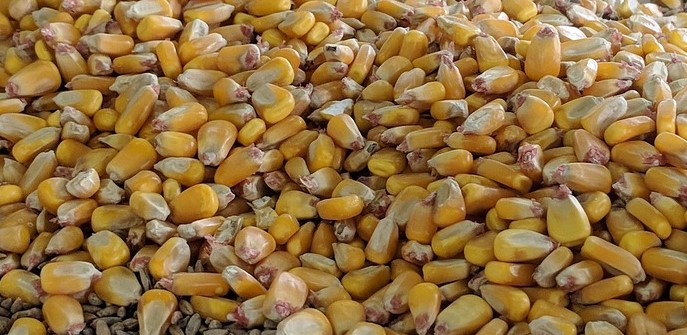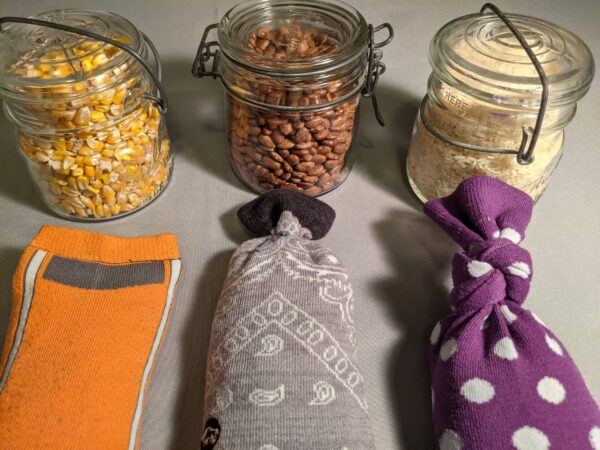How to Make a Cheap Cold Pack Using a Sock & Dry Beans
This post may contain affiliate links, please see my disclosure policy to learn more.
Easy ways to make microwavable heat packs, including no-sew methods. Heat packs can be used in so many ways. They can help relieve cramps, arthritis, headaches or growing pains. Ease sore muscles after a workout or when feeling run down. Warm up your bed before going to sleep. They also make excellent bed warmers for your pets. Small packs can be kept in your pockets and used as hand warmers when outdoors.
Fillers
Three of the most common fillers for heat packs include rice, dried beans or corn (feed or bird corn). These fillers are great inexpensive choices and the packs you make with them can be used as either hot or cold packs.

Rice – Long grain white rice is one of the most common choices for heat/cold packs. White rice is usually easy to find in stores in bulk. Brown rice is more expensive than white rice, puts out more of an odor and can leave a powdery residue, so I don't recommend it. I also don't recommend Instant rice which can burn easily and does not smell pleasant when heated. All rice breaks down after repeated microwaving or freezing and can take on a peculiar odors, so it will need to be replaced more often than some of the other choices.

Dried Beans or Lentils – Usually easy to find in grocery stores in bulk, relatively inexpensive to replace, does not break down as easily as rice. Doesn't hold heat as long as rice does, so you'll need to warm it more often. It can take on strange odors after repeatedly being microwaved or frozen, so the beans will need to be replaced when that happens.

Corn – Whole feed corn, not Popcorn . Dry whole feed corn can be microwaved or frozen over and over before breaking down. It is cheaper than rice or beans, around $7 for a 40 lb. bag. Can be found in the hunting or pet section of Walmart, or in farm, garden or pet stores. It can last for years before needing to be replaced. Eventually the corn will dry out and need to be replaced.
No matter which filler you use, they will all smell of whatever you filled them with. Corn will smell like corn, rice will smell like rice and beans will smell like beans. You can alter the smell somewhat by adding essential oils if you wish. Mix 10-20 drops of essential oil with your filler and let it sit for about 10 minutes until it's absorbed, before filling your sock. You could also add dried herbs, such as rosemary, spearmint, lavender, cinnamon or cloves to your filler.
Fabric
Most natural fabrics can be microwaved safely. Cotton, linen, hemp and wool are the best fabrics to use when making microwave-safe crafts. Synthetic fabrics should not be used as they can contain plastic, which can melt or become extremely hot and difficult to handle when microwaved. In some cases, the fabric could even catch fire. Use caution, and monitor anything you put in the microwave!
Assembly
If you sew you can easily make permanent heat packs by folding a piece of fabric in half with right sides together. Stitch along two of the three open sides to make a pocket. Fold the fabric right-side out and fill about 3/4 full with your choice of filler. Stich the remaining side closed, backstitching to secure the seam.
Make some using recycled clothing items. Such as handkerchiefs, shirt sleeves, kids pants or tight legs, or old flannel pj's. Even cotton dish or hand towels will make great heat packs.
But the easiest way to make a heat pack is to take a (non-holy) clean sock and fill it 2/3 to 3/4 full with your choice of filler. You don't want to pack it too tightly, allow some room for the filling to move around, so you can form it easily to the area to be treated.
If you use a long sock you can just tie the end in a knot. Otherwise you can use a piece of cotton string, yarn or ribbon to tie the open end of the sock closed. If you sew, you can sew the sock shut.

Heating
When heating a new hot pack, heat it up in 30-second intervals, testing after each interval, until you learn how long it takes to heat up your pack without over-heating it. Most packs take 1-3 minutes depending on the filler and your microwave. Corn heats up much faster than rice! To prevent burns, always test the heat pack on the inside of your arm before applying it to other parts of your body. It should feel warm, but not overly hot.
Cold pack
To use as cold pack just place the rice, bean or corn bag inside of a Ziploc freezer bag and keep in freezer until needed. Take out of the freezer bag when ready to use, the cold pack will mold to the body providing cold relief for inflammation and swelling. Make one specifically to be kept in the freezer and it will be cold whenever you need it.
How to Make a Cheap Cold Pack Using a Sock & Dry Beans
Source: https://www.thefrugaler.com/diy-microwavable-heat-packs/
0 Response to "How to Make a Cheap Cold Pack Using a Sock & Dry Beans"
Post a Comment